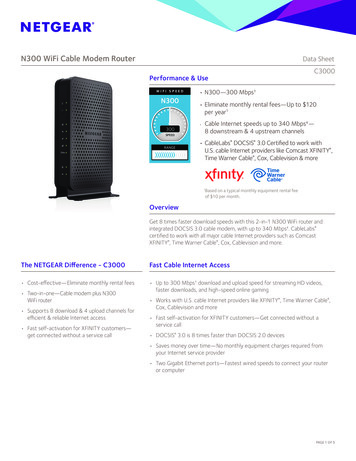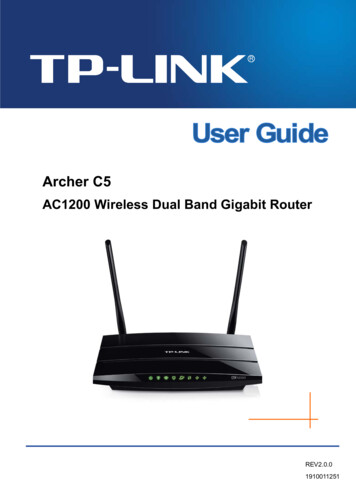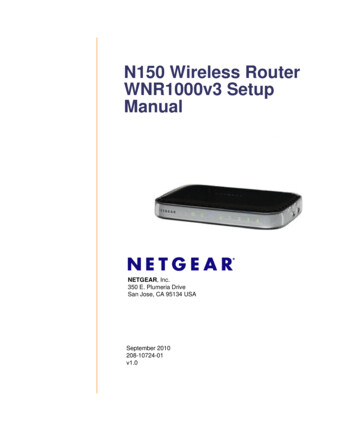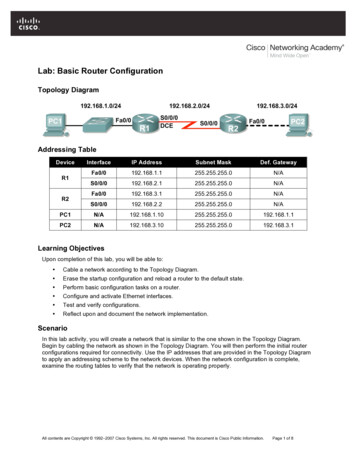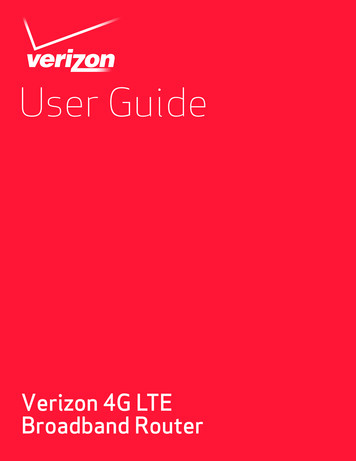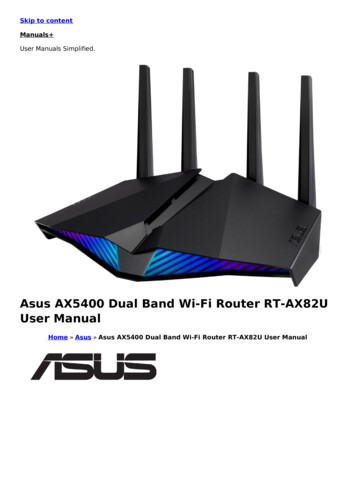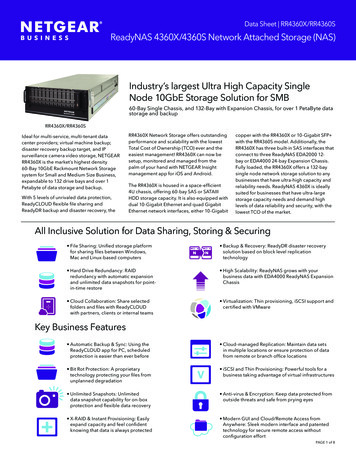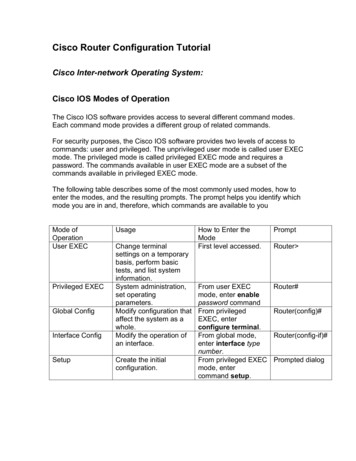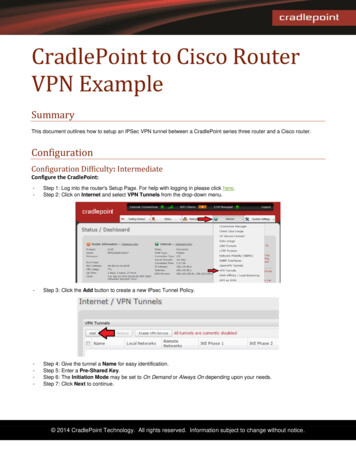
Transcription
N300 Wireless GigabitRouter Setup ManualNETGEAR, Inc.350 E. Plumeria DriveSan Jose, CA 95134 USAJune 2010208-10443-03v1.0
2010 by NETGEAR, Inc. All rights reserved.TrademarksNETGEAR and the NETGEAR logo are trademarks of NETGEAR. Inc. Microsoft, Windows, and Windows NT areregistered trademarks of Microsoft Corporation. Wi-Fi Protected Setup is a trademark of the Wi-Fi Alliance. Otherbrand and product names are registered trademarks or trademarks of their respective holders.Statement of ConditionsIn the interest of improving internal design, operational function, and/or reliability, NETGEAR reserves the right tomake changes to the products described in this document without notice.NETGEAR does not assume any liability that may occur due to the use or application of the product(s) or circuitlayout(s) described herein.ii
ContentsN300 Wireless Gigabit Router Setup ManualGetting to Know Your Wireless Router. 1Unpacking Your New Router . 1Hardware Features . 3Front Panel . 3Back Panel . 5Router Label . 5Positioning Your Wireless Router . 6Installing Your N300 Wireless Gigabit Router . 6Updating Your Router Firmware . 7Installing Your Router Using the Smart Wizard . 9Using the Smart Wizard . 9Accessing Your Router After Installation . 11Manually Installing Your Router . 12Connecting Your N300 Wireless Gigabit Router . 13Verifying Your Connection . 17Setting Up Your Router for Internet Access . 18Configuring Your Wireless Network. 22Specifying Wireless Settings . 22Setting Your SSID and Wireless Security Manually . 23Using Push 'N' Connect (WPS) to Configure Your Wireless Network .24Testing Basic Wireless Connectivity . 29Troubleshooting. 30Basic Setup Checklist . 30Checking Basic Router Functions . 31Troubleshooting Login Problems . 33Checking the Internet Service Connection . 34iii
Obtaining an Internet IP Address . 34Troubleshooting PPPoE . 35Troubleshooting Internet Browsing . 36Using the Ping Utility to Troubleshoot . 36Testing the Path from Your Computer to Your Router . 36Testing the Path from a Computer to the Internet . 37Technical Specifications . 39Default Configuration Settings . 39Restoring the Default Password and Configuration Settings . 40Technical Specifications . 41Related Documents . 43Registration and Certifications. 44iv
Getting to Know Your Wireless RouterCongratulations on your purchase of a NETGEAR high-speed wireless router, the N300Wireless Gigabit Router Model WNR3500L.The WNR3500L is also the NETGEAR Open Source Wireless-N Router. If you are interested incustom firmware and other third party applications, be sure to visit the Open Source communityweb site http://www.myopenrouter.com.Before you begin installing your router, check the package contents (see “Unpacking Your NewRouter” on page 1). Become familiar with the front and back panels of your router—especially thestatus lights—and the important information on the router label (see “Hardware Features” onpage 3). Then, read the section on “Positioning Your Wireless Router” on page 6 to ensure thatyou have selected the best location to install your router.Unpacking Your New RouterYour product package should contain the following items: The Wireless Router A snap-on stand for your N300 Wireless router An AC power adapter (varies by region) A yellow Ethernet cable NETGEAR Installation Guide The Resource CD, which includes:–The Smart Wizard (Autorun.exe)–A PDF version of this manual–A link to the online User ManualAfter your router is installed and you have Internet access, you can accessthe online User Manual by clicking Documentation on the main menu.Getting to Know Your Wireless Router1
If any of the parts are incorrect, missing, or damaged, contact your NETGEAR dealer. Keep thecarton, including the original packing materials, in case you need to return the product for repair.To prepare your router for installation:1. Carefully peel off the protective film covering both sides of your router (see Figure 1).Figure 12. Set up your N300 Wireless router by inserting the tabs of the stand (supplied with your router)into the slots on the bottom of your router as shown in Figure 2. Then, remove the protectivefilm covering the status light panel of the router.Figure 2Getting to Know Your Wireless Router2
3. Place your router in a suitable area for installation (near an AC power outlet and accessible tothe Ethernet cables for your wired computers).To ensure proper heat dissipation and for router stability, it is important that youconnect the stand and place your router in an upright position.Hardware FeaturesBefore you install and connect your router, take a moment to become familiar with importantinformation on the label, and with the front and back panels of the router—especially the statuslights on the front panel.Front PanelThe router front panel, shown in Figure 3, contains status lights. (For more information oninterpreting the status lights, see “Verifying Your Connection” on page 17 and “Checking BasicRouter Functions” on page 31.)Getting to Know Your Wireless Router3
PowerOn – AmberOn – GreenBlink – AmberBlink – GreenOffInternetOn – AmberOn – GreenBlink – GreenOffWirelessOn – BlueBlink – BlueOffLAN (Ports 1–4)On – GreenBlink – GreenOn – AmberBlink – AmberOffWPS button/lightBlink – GreenOn – GreenThe router is performing the power-on self-test diagnostic.The power is on and the router is ready.A software update is in progress.The firmware is corrupt. See “Checking Basic RouterFunctions” on page 31 for instructions on restoring yourfirmware.Power is not being supplied to the router.No IP address acquired.The N300 Wireless router has acquired an Internet address.Data is being communicated with the Internet.No Ethernet cable is connected to the modem.The wireless interface is enabled.Data is being communicated over the wireless network.The wireless interface is turned off.The local port is connected to a 1000 Mbps device.Data is being transmitted at 1000 Mbps.The local port is connected to a 10/100 Mbps device.Data is being transmitted at 10/100 Mbps.No link is detected on this port.Indicates WPS activity; the device is in the 2 minute intervalto synchronize security or there is a WPS error.Security set to WEP, WPA-PSK, or WPA2-PSK.Figure 3Getting to Know Your Wireless Router4
Back PanelThe router back panel contains port connections described in Figure 4.1. Restore factory settings button. Press for approximately 5seconds to reset the router to the factory default settings.2. USB port3. Four Local Area Network (LAN) 10/100/1000 Mbps Ethernetports for connecting the router to your local computers.4. Internet/Wide Area Network (WAN) Ethernet port for connectingthe router to a cable or DSL modem.5. Power on/off push-button.6. AC power adapter outlet for connecting the power adapter.Figure 4Router LabelThe label on the back of the N300 Wireless router shows the router’s MAC address, serial number,security PIN, power on/off button, and factory default access login information.The ports on the router are color-coded to distinguish your Internet port from the other four portsthat connect to the wired computer(s) on your Local Area Network (LAN).Figure 5Getting to Know Your Wireless Router5
Positioning Your Wireless RouterThe N300 Wireless router lets you access your network from virtually anywhere within theoperating range of your wireless network. However, the operating distance or range of yourwireless connection can vary significantly depending on the physical placement of your router. Forexample, the thickness and number of walls the wireless signal must pass through might limit therange. For best results, place your router: Near the center of the area where your computers and other devices will operate, preferablywithin line of sight to your wireless devices. Accessible to an AC power outlet and near Ethernet cables for wired computers. In an elevated location such as a high shelf, keeping the number of walls and ceilings betweenthe N300 Wireless router and your other devices to a minimum. Away from electrical devices which are potential sources of interference, such as ceiling fans,home security systems, microwaves, or the base for a cordless phone. Away from any large metal surfaces, such as a solid metal door or aluminum studs. Largeexpanses of other materials such as glass, insulated walls, fish tanks, mirrors, brick, andconcrete can also affect your wireless signal. Failure to follow these guidelines can result in significant performancedegradation or an inability to wirelessly connect to the Internet.Warning: Do not install this device on top of any other electrical equipment or installany other equipment on top of this device. Keep this device away from anyheat sources such as direct sunlight, heaters, radiators, or other A/Vreceivers or devices that emit heat.Installing Your N300 Wireless Gigabit RouterTo help you set up your router and get on the Internet quickly, the Resource CD contains a SmartWizard . The Smart Wizard walks you through the steps required to connect your router, modem,and PC(s); configure your wireless settings; and enable wireless security for your network. WhenGetting to Know Your Wireless Router6
you have finished, you will be Internet ready! If you have a Linux system, you need to use themanual installation method (see “Manually Installing Your Router” on page 12).NETGEAR does not recommend or support adding a NETGEAR router behindanother router, or replacing a gateway with a a NETGEAR router.You can set up your N300 Wireless router using one of two methods: Smart Wizard Setup: The Smart Wizard setup is available on your Resource CD. See“Installing Your Router Using the Smart Wizard” on page 9 to use the Smart Wizard.This is the easiest option. The wizard guides you through the setup process. It automates manyof the steps and verifies that the steps have been successfully completed.Before running the Smart Wizard on a corporate PC to set up your homerouter, check with your company’s network support staff. Corporatenetwork settings or Virtual Private Network (VPN) client software mightconflict with the default settings of a home router. If you are unsure aboutwhether there might be a conflict, use a different computer. Manual Setup: If you cannot or prefer not to use the Smart Wizard, see “Manually InstallingYour Router” on page 12. For example, if you are using a Linux operating system, or aretechnically knowledgeable, select this option. If you choose to use this option and install yourrouter manually, for best results, install and set up your router in this order:1. Install and connect your wireless router to your network (see “Connecting Your N300Wireless Gigabit Router” on page 13).2. Set up your wireless router for Internet access (see “Setting Up Your Router for InternetAccess” on page 18).3. Configure your wireless network and select wireless security settings to protect yourwireless network (see “Configuring Your Wireless Network” on page 22).Updating Your Router FirmwareNETGEAR is always improving the operability and features included with your router. To make iteasy for you to receive the best, most up-to-date features of your router, NETGEAR provides avariety of methods for updating your product. The Smart Wizard lets you check for and install updates as part of the setup activity (see“Using the Smart Wizard” on page 9).Getting to Know Your Wireless Router7
The router includes an update feature that lets you check for and install updates. You must login to the router to use this feature see “Setting Up Your Router for Internet Access” onpage 18, or the online User Manual).Getting to Know Your Wireless Router8
Installing Your RouterUsing the Smart WizardThe Smart Wizard setup procedure should take about 15 minutes to complete. Before using theSmart Wizard, ensure that: You are using a PC with either a Mac operating system or a Windows operating system(Windows 7, Windows Vista, Windows 2000, or Windows XP with Service Pack 2); and awired Ethernet connection, not a wireless connection. You have an Internet service connection through an Internet Service Provider (ISP). You have the configuration information provided by your ISP.Using the Smart WizardThe NETGEAR Smart Wizard takes you through the procedure to connect your router, modem,and PCs. It then helps you to configure your wireless settings and enable wireless security for yournetwork. The Smart Wizard guides you through the setup process by automating many of thesteps. At each step in the setup process, the Smart Wizard checks to ensure that the steps youperform are successfully completed.To set up your router using the Smart Wizard:1. To start the Smart Wizard: For Windows users,–Insert the Resource CD into your PC. The CD will automatically start and detect thelanguage you are using on your PC. Select a different language option, if you prefer.If the CD does not automatically start, browse the CD and double-clickon.– In the CD’s menu, click Setup to start the Smart Wizard.For Mac users, double-click the MacWizard program.Installing Your Router Using the Smart Wizard9
2. When the Smart Wizard prompts you about updates, click Yes to check for updates for yourrouter, or No, to update later (for more information, see “Setting Up Your Router for InternetAccess” on page 18, or the online User Manual).3. Follow the remaining instructions and prompts.The Smart Wizard guides you through installing your router, connecting your router to theInternet, configuring your wireless network settings, and selecting the optimum securityprotection for your network. If you choose not to select a security option during installation,you can always access the router’s user interface later to select a security option (see“Configuring Your Wireless Network” on page 22).To ensure optimum performance of your high-speed wireless router, thewireless adapter card for each computer in your network should support thesame technology as your router. For more information, see the online UserManual.At the close of installation: For Windows users, the Smart Wizard places a Router Setup.html file on yourcomputer’s desktop so that you can view the router settings. It also places the RouterLoginshortcut on the desktop for you to access the router’s main menu. For Mac users, the Smart Wizard places a Router Setup.pdf file on your desktop.You are now connected to the Internet.Figure 6Installing Your Router Using the Smart Wizard10
To set up additional wireless computers in your network to access the router and connect to theInternet, see “Configuring Your Wireless Network” on page 22.Accessing Your Router After InstallationThe Smart Wizard only appears when you first install the router or when the router is in its factorydefault state (for example, if you have reset the router to its default factory settings). If you want tochange the settings after installing and configuring your router using the Smart Wizard, you mustopen a browser window and log in to the router. You will also be prompted to check for new routerfirmware. For more information, see “Configuring Your Wireless Network” on page 22.Installing Your Router Using the Smart Wizard11
Manually Installing Your RouterBefore installing and connecting your router manually, review the list below and make sure thatyou have all of the necessary information. Follow these procedures if you are an advanced user, oryou are installing this router on a Linux system.NETGEAR does not recommend or support adding a NETGEAR router behindanother router, or replacing a gateway with a NETGEAR router. Internet service connection through an Internet Service Provider (ISP).The configuration information your ISP gave you. Depending on how your Internet accountwas set up, you might need the following information to set up your N300 Wireless router andaccess the Internet:–Host and domain name–Internet login name and password (frequently an email address and password)–Domain Name Server (DNS) addresses–Fixed or static IP addressYour ISP should have provided you with all the information needed to connect to the Internet.If you cannot locate this information, ask your ISP. If you have cable modem service, make sure that you are using the same computer on whichyou first set up your Internet account.If you have not already done so: Check the package contents of your router to ensure that it is complete (see “Unpacking YourNew Router” on page 1”). Select an optimum location for your N300 Wireless router after reviewing the guidelinespresented in “Positioning Your Wireless Router” on page 6.”Manually Installing Your Router12
Connecting Your N300 Wireless Gigabit RouterBefore you install your N300 Wireless router, make sure that the Internet Protocol (TCP/IP)Property settings on your computer are set to “automatically obtain an IP address” using DHCPand “Obtain DNS server address automatically.” You can check these settings by looking at theTCP/IP Properties of your Internal Network Connections, which are accessible through theControl Panel of your computer. If you are unsure about this, refer to the documentation for yourcomputer or see the link to TCP/IP Addressing in “Related Documents” on page 43.If you are replacing an existing router, disconnect it completely from your networkand set it aside before starting to install your new router, then go to “To replaceyour wireless router:” on page 15.To connect the N300 Wireless router, the computer, and the modem:1. Turn off and unplug the power to the broadband cable modem or DSL modem.2. Locate the Ethernet cable (A) that connects your computer to the modem.3. Disconnect the Ethernet cable at the modem end only (B). You will connect it to the routerlater.ABFigure 74. Locate the Ethernet cable that came with your NETGEAR product. Securely insert one end ofthe Ethernet cable into your modem (C) and the other end into the Internet port of the N300Wireless router (D). The Ethernet cable and the Internet port label are color coded.Manually Installing Your Router13
tCDFigure 85. Locate the Ethernet cable (A) that is still attached to your computer. Securely insert the otherend of the Ethernet cable into a port on the router, such as port 4 (E), as shown in Figure 9Connect any additional wired devices to your router by inserting an Ethernet cable from adevice into one of the three remaining LAN ports.AEFigure 96. Ensure that your network is now set up in the order shown in Figure 10; you are now ready torestart your network.Manually Installing Your Router14
Figure 107. Start your network in the correct sequence, as described in “To start your network:”.Failure to start or restart your network in the correct sequence could prevent youfrom accessing the Internet.To replace your wireless router:1. Turn off and unplug the power from your broadband cable modem or DSL modem.2. Remove both Ethernet cables from your existing router (but leave both cables attached to yourcomputer and your modem).3. Locate the Ethernet cable (A) that is still attached to your computer. Securely insert the otherend of the Ethernet cable into a LAN port on your new router, such as port 4 (E), as shown inFigure 11.Connect any additional wired devices to your new router by inserting an Ethernet cable from adevice into one of the three remaining LAN ports.Manually Installing Your Router15
AEFFigure 114. Replace the Ethernet cable connected to your modem with the Ethernet cable that came withyour router, and insert one end into the same port on the modem. Then, insert the other endinto the Internet port of your new router (F), as shown in Figure 11.5. Start your network in the correct sequence, as described below.Failure to start or restart your network in the correct sequence could prevent youfrom accessing the Internet.To start your network:1. Plug in the power and turn on the broadband cable modem or DSL modem. Wait 2 minutes.2. Plug the end of the power adapter cord into the wall or a power strip, and insert the other endinto the power adapter outlet of your N300 Wireless router (G), shown in Figure 12.3. Make sure that the Power button on the back of your router (H) is in the power-on state. (Thebutton is depressed when in power-on mode.) Wait 1 minute.Manually Installing Your Router16
HGFigure 124. Turn on your computer. It will take several minutes for your router to establish a connectionwith your computer and your Internet provider.For DSL customers, if software logs you in to the Internet, do not run thatsoftware. You might need to go to the Internet Explorer Tools menu, InternetOptions, Connections tab and select “Never dial a connection.”Verifying Your ConnectionVerify that your router is connected correctly by checking the N300 Wireless router status lights(as illustrated in Figure 13).Manually Installing Your Router17
Power. The power light should turn solid green. If it does not, see“Checking Basic Router Functions” on page 31.Internet. The Internet port light should be lit. If it is not, make sure theEthernet cable is securely attached to the N300 Wireless router Internetport and the modem, and that the modem is powered on.Wireless. The wireless light should be lit after turning on the ProductFamily.LAN. A LAN light (1-4) should be lit for each connected computer onyour network. Green indicates that your computer is communicating at1000 Mbps; amber indicates communication at 10/100 Mbps. If a LANlight is not lit for each connected Ethernet cable, make sure that theEthernet cable from the computer to the router is securely attached atboth ends, and that the computer is turned on.WPS. The WPS light will blink if you are in the process of using WPS toadd a wireless client or there is a WPS error. See “Using Push 'N'Connect (WPS) to Configure Your Wireless Network” on page 24. TheWPS light will be lit if WEP, WPA-PSK or WPA2-PSK security is set.Figure 13Setting Up Your Router for Internet AccessWhen configuring your wireless router manually, you must log in to your N300 Wireless router toset it up initially and to make any changes to your wireless router’s settings later.The factory default state is reset when you use the Restore Factory Settings button.See “Restoring the Default Password and Configuration Settings” on page 40 formore information.To access the router:1. Type http://www.routerlogin.net in the address field of your browser, and then click Enter.You can enter either of these addresses to connect to your wireless router:http://www.routerlogin.net or http://www.routerlogin.com.Manually Installing Your Router18
A login window similar to the one shown in Figure 14 will display.Figure 142. When prompted, enter admin for the router user name and password for the router password,both in lowercase letters. (For security reasons, the router has its own user name andpassword.)The router user name and password are not the same as any user name orpassword you might use to log in to your Internet connection.The Firmware Upgrade Assistant screen will display.3. Click Yes to check for new firmware (recommended). The router will automatically check theNETGEAR database for a new firmware image file. If no new firmware version is available,the message “No New firmware Version Available” will display. (If you select “No,” you cancheck for new firmware late; see the online User Manual.4. If new firmware is available, click Yes, and the router will automatically upgrade itself withthe latest firmware.Do not try to go online, turn off the router, shut down the computer, or doanything else to the router until the router finishes restarting! When the Readylight stops blinking, wait a few seconds more before using the router.Do not try to go online, turn off the router, shut down the computer, or doanything else to the router until the router finishes restarting! When the Readylight stops blinking, wait a few seconds more before using the router.Manually Installing Your Router19
5. From the menu options in the left navigation pane, click Setup Wizard. The Setup Wizardscreen will display.Figure 156. Select one of the following options: Select Yes to allow the Setup Wizard to detect your Internet connection. When prompted,click Next. The wizard will assist you with configuring your wireless router to access theInternet.If you cannot connect to the wireless router, check the Internet Protocol(TCP/IP) properties in the Network Connections section of your ControlPanel. It should be set to obtain both IP and DNS server addressesautomatically. For assistance, see your computer documentation or see thelinks in “Related Documents” on page 43. Select No to set up the connection yourself. Click Next and the Basic Settings screen willdisplay. Enter the required information for your ISP connection in the appropriate fields. Ifyou need assistance, follow the Basic Settings Help screens on the router interface or seethe online User Manual for this N300 Wireless router.For more information about configuring settings, see “Configuring YourWireless Network” on page 22.7. Click Apply to save your settings and complete your connection.You should now be connected to the Internet!Manually Installing Your Router20
If you do not connect successfully: Review your settings and make sure that you have selected the correct options and typedeverything correctly. Contact your ISP to verify that you have the correct configuration information. Read “Troubleshooting” on page 30.If problems persist, register your NETGEAR product and contact NETGEAR Technical Support.Manually Installing Your Router21
Configuring Your Wireless NetworkThis section describes additional configuration and testing for your network, after you haveperformed basic installation of the Wireless Router.For a wireless connection, the router and each wireless computer must use the same SSID, alsocalled the wireless network name, and the same wireless security. NETGEAR stronglyrecommends that you use wireless security.Indoors, computers can connect over wireless networks at a range of several hundredfeet. This can allow others outside of your immediate area to access your network.Specifying Wireless SettingsThe Wireless Settings screen lets you set your wireless network connections, specify your networkname (SSID), and set the wireless security option for your router. To configure the wirelessnetwork, you can either manually specify your network name and your wireless security settings(see “Setting Your SSID and Wireless Security Manually” on page 23) or, if the clients in yournetwork are WPS capable, you can use Wi-Fi Protected Setup (WPS) to automatically transmityour WPA/WPA2 security settings to the client device (see “Using Push 'N' Connect (WPS) toConfigure Your Wireless Network” on page 24).NETGEAR’s Push 'N' Connect feature is based on th
June 2010 208-10443-03 v1.0 NETGEAR, Inc. 350 E. Plumeria Drive San Jose, CA 95134 USA
